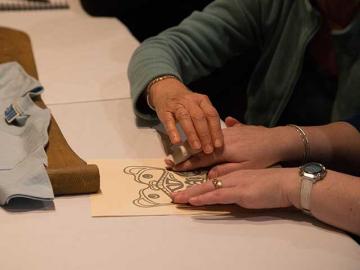Improving Access for Visually-Impaired Visitors
Oxford University Museums Partnership

New collaboration between e-Research Centre and Oxford University Museums aims to bring visual art to life for blind and partially sighted people. The 18 month Multisensory Access project aims to improve the independent museum experience for blind or partially sighted people (BPSP) and other visitors with technology that is unobtrusive, easy to use and quick and simple to create.
A new joint project between Oxford University’s e-Research Centre and Oxford University Museums will develop multisensory tools to help enable blind or partially sighted people (BPSP) to engage in a more accessible and meaningful way with visual arts. The project will be working in partnership with local BPSP communities, as the primary users of the technology, to help develop the tools.
The project, starting in September 2016, will marry the expertise of the e-Research Centre in developing and applying technology in research and industrial applications, with the Museums’ in-depth knowledge and expertise in public engagement. The project builds on recent work by the Oxford University Museums with blind and partially sighted people through the HLF-funded “Sensing Culture” project led by the Royal National Institute of Blind People (RNIB), and current research in the Department of Experimental Psychology into how BPSP perceive pictures.
The RNIB estimates that there are about two million people in the UK who are registered blind or partially sighted. Because so much of what is presented in galleries is visual, BPSP can face a diminished visitor experience. Mrs Pamphilon, who runs a social group for visually impaired people in Oxfordshire, says: “I get really frustrated when I go to a museum and there’s no way to experience it. Having things you can touch and feel just opens up a whole new world”.
Currently museums tend to provide raised ‘touch tiles’ which give a physical indication of the visual shapes and textures of an artwork. However, research has shown that the raised images are both difficult to interpret and miss fine nuances of the piece, and often require specialist audio description provided by a trained member of staff.
The cost and logistics of providing this significantly restricts the opportunities for blind and partially sighted people to have the independent museum experience which the majority of visitors enjoy. To tackle this issue, museums internationally are experimenting with solutions to improve BPSP access to 2D and fragile 3D art (for example a recent exhibition in Spain’s Prado Museum which invited blind and partially sighted people to touch specially-created copies of works by masters such as El Greco and Francisco Goya).
The 18 month collaboration, funded by the University’s IT Innovation Fund, aims to further develop the touch tile approach, using techniques such as 3D printing to improve the touch elements of the tile, and using cheap and simple technology such as Raspberry Pi to deliver pre-recorded audio descriptions. This should decrease the cost to museums of giving BPSP an experience more akin to that of the majority of museum visitors, and therefore increase availability and accessibility for BPS visitors. The aim is to allow BPSP visitors to engage with both 2D and 3D artworks intuitively, dipping in and out and being able to select the part of the audio description they are interested in (rather than being restricted to a fixed linear recording).
Susan Griffiths, Community Engagement Officer at Oxford University Museums, says, “Our aim is to create a tool that can allow blind and partially sighted people to independently engage with some of the world famous visual arts held by the Oxford University Museums, in particular the Ashmolean. We will be building on our existing knowledge from working with local BSP communities and taking it forward in an exciting new direction. We hope it will not only benefit BPS visitors, but improve the visitor experience for everyone coming to the museums”.
The technology should provide new, tactile ways of engaging and understanding the collections to broader museum audiences, such as visitors with dementia or autism. In keeping with the interdisciplinary nature of the work of the Oxford e-Research Centre, the technology could have significant applications beyond museums, for example, by supporting equal access for University BPS students in arts-based and other subjects.
Strand one of the project, led by the Museums with support from Dr Torø Graven (Department of Experimental Psychology), will focus on understanding the tactile sensations that can be used to assist BPSP to experience the tiles (e.g. line fineness, texture of lines and surfaces, shape of features such as curves and angles, use of colour for partially sighted people), what kind of audio description should accompany the tiles and how it should be activated. The team will research existing approaches being taken by other museums, arts organisations, companies and BPS groups, with whom the Museums already have strong links.
The R&D strand, led by the e-Research Centre, will determine how best to develop cheap and efficient methods of creating touch tiles that can provide the tactile sensations identified in strand one. It will also develop practical and replicable approaches to integrating audio delivery into the touch tiles.
Thirdly, the project team will select works of art from the Ashmolean’s Western Art collection to prototype and user-test the technology. Learnings from this will be used to fine tune the user experience and gain a deeper understanding of the impact of this technology on the BPSP experience of visual art. At the end of the prototyping phase an installation of the touch tiles in the Ashmolean Museum will allow testing and evaluation with BPS visitors in a real-world environment.
Professor David De Roure of the Oxford e-Research Centre says, “We are very pleased to be working with the Oxford Museums on this innovative partnership, combining the Centre’s expertise in digital methods and ability to work across traditional disciplinary boundaries, with the Museums’ expertise in delivering a quality visitor experience to some of the world’s most important collections”.



